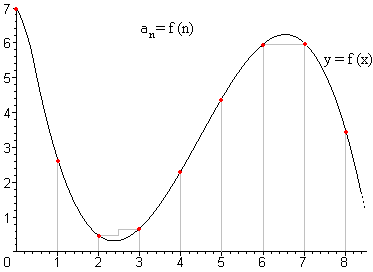A sequence is a sorted and infinite collection of real numbers. Small letters usually denote the sequences.
Example
Here are some sequences:
To give a sorted list of numbers is to determine which is the first one, the second one, the third one... or in mathematical terms, it means to associate every natural number one and only one real number; that is, a sequence is an application of the set of natural numbers to the set of real numbers:
Example
The previous sequences are written:
The numbers that form the sequence are called terms, and we usually refer to them using the letter that names the sequence with a subscript that indicates the position the above mentioned term occupies in the sequence:
The symbol
Example
Using the previous examples, we have
General term of a sequence
If the terms of a sequence follow a certain law in its formation, that is, if it is possible to give a formula that relates the value of the
We can also interpret the general term as a real function, and then the sequence is interpreted as the values which the function takes in the natural numbers.

Example
In the sequence
In the sequence
To notice that the sequence is an application of the set of natural numbers, that is
Sequences recursively defined
Sometimes, when calculating the n-th term of a sequence, it is easier from the previous term, or terms than from the position it takes. In this case, although we are not giving the general term of the sequence, it is accepted as its definition, and it is said that the sequence is defined recursively. In these occasions, in addition to giving the formula that defines the sequence, it is necessary to give the first, or the first terms.
Example
In the sequence
so we may also define the sequence as
Example
Let's see another example where we verify that to define the sequence not always the previous term only is needed. We define the sequence in the following way;
This sequence is called a Fibonacci sequence. This sequence has numerous mathematical properties but it was, curiously, presented through a study on the reproduction rates of rabbits.
